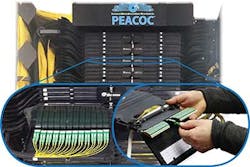With Big Densification Comes Big Responsibility
Intelligent Fiber Management for Next-Gen Latency Challenges —
It’s 2020. We’re living in the Golden Age of both bingeworthy and cringeworthy OTT content. Streaming is
indeed the reigning killer app, and, according to Amara’s Law (We tend to overestimate the effect of a technology in the short run and underestimate the effect in the long run.), it’s likely to remain so for a bit longer than some of us might expect.
That’s why downstream bandwidth maintains its status as the defining metric for what we generally mean today by broadband Internet. It’s what we want, it’s what we pay for, and it’s what we need to keep track of Mrs. Maisel’s wardrobe and Frank Sheeran’s crime spree. In fact, downstream is such a big deal these days that at the FCC, where things like broadband get defined, upstream speeds are barely on the radar.
Latency doesn’t even get a cameo.
But just wait and see: latency will soon be a rising star. For while our video obsession isn’t going anywhere just yet, the next generation of killer apps will not only require faster bi-directional speeds, it will even more critically depend upon consistent order-of-magnitude cuts in request/response times. For designers of tomorrow’s networks, "the focus has shifted from merely increasing the data communication rate to providing service-specific performance guarantees in terms of ultra-reliability and low latency."*
InvisiLight® Solution for Deploying Fiber
April 2, 2022Go to Market Faster. Speed up Network Deployment
April 2, 2022Episode 10: Fiber Optic Closure Specs Explained…
April 1, 2022Food for Thought from Our 2022 ICT Visionaries
April 1, 2022Delivering the bandwidth and, especially, achieving the <5ms latency benchmarks needed to enable Star Trek-level miracles like immersive virtual reality and telesurgery over both wireless and wireline interfaces, will necessitate dramatic improvements in network performance.It’s widely acknowledged that these improvements will be conditioned upon a dramatically densified infrastructure — not only to implement growing connectivity needs for inside/outside plant and direct links to an expanding population of high capacity wireline end users, but also to accommodate the emergence of next-gen sources of connectivity demand: proliferating MEC facilities and the soon-to-be ubiquitous microcells required by 5G, particularly in its up-spectrum manifestations. Your phone might be wireless, but your neighborhood antenna won’t be; it will require backhaul to the Internet and also, in many, if not most, cases, fronthaul to a centralized base station.
Not as Easy as It Looks
Effective management of the vastly more complex architectures needed to support the hyper fast, symmetrical, and ultra-reliable low latency communication (URLLC) networks of the future will require development of innovative approaches to network operations control. From traditional service providers to cloud data centers, operators of densified next-gen optical networks will require versatile connectivity solutions oriented for fast, simple, cost-effective field deployment. These solutions must ensure low-cost, low-maintenance operation over the life of the network without compromising the highest standards for performance, quality and reliability.
Obviously, they must also be scalable.
And because, as implied by Amara’s Law, the future has a way of sneaking up on us rather than just abruptly showing up and announcing itself, going all-in at the outset is not necessarily a viable option for most operators. Instead these solutions must be compatible with today’s network while affording operators the flexibility to evolve legacy infrastructures toward fully next-gen-ready high-density connectivity.
Moreover, the intelligence of the network must be capable of scaling with the network. Optical surveillance, working-protection, and fast-provisioning processes have typically been supported in network element management systems but maintaining reliability while building out both the dependable high-data-rate bi-directional throughput and near-zero latencies demanded by tactile and presence applications will challenge the intelligence capabilities of today’s networks.
For the intelligent fiber management (IFM) of tomorrow, every component in the network, including the connections themselves, must be capable of being monitored, measured, and held accountable. The goal: always-on end-to-end visibility of ever-denser infrastructure, including precise physical layer (Layer 0) sensing at every fiber junction.
Go!Foton’s spreadable PEACOC cassette provides operators with greatly enhanced tool-less accessibility to fiber connections, especially in high-density implementations.
Optical Options for IFM
Let’s review 9 optical component technologies for their potential to meet the monitoring and scalability requirements for true IFM.
1. Fused Biconical Taper Splitters (FBT)
Due to their optical performance limitations, FBT splitters can serve only at certain or specified wavelengths on single mode fiber.
For multimode applications, this simple power splitter cannot be controlled very well, and may be subject to optical power fluctuations depending on the modes transmitted in the optical signal. As such, FBTs are not suitable for broadband applications, and may have only limited use in Wave Division Multiplexing (WDM) applications.
2. Thin Film Filters (TFF)
Unlike FBT, TFF technology can be used in optical power splitters for broadband WDM and DWDM applications. TFFs can be designed for customer-specific requirements in power, wavelength separation, express optical channels, and channel-band reflectors, across a wide variety of wavelength plans.
Per basic optical interference theory, multiple layers of optical coatings may be required; however, the resulting performance and reliability of the TFF optical devices are exceptionally high.
TFF challenges include miniaturization, number of coatings needed, and cost control.
3. Arrayed Wave Gratings (AWG) and Interleaver
These technologies are widely used in Wave Division Multiplexing (WDM) and Dense Wave Division Multiplexing (DWDM) products today. Mass production is now practical at the chip level, but challenges remain for temperature sensitivity and fine control of the optical path. Packaging of AWGs can be realized in the range of millimeters, enabling use in typical transceiver form factors (TO/RO/BO-SA: Transmitter Optical/Receiver Optical/Bi-directional Optical Sub-Assemblies).
The optical performance of AWGs, however, is only average due to the difficulty of maintaining inter-channel crosstalk below 35dB.
When cascading AWG components together, optical insertion loss can also be an issue.
4. Micro-Electromechanical Systems (MEMS)
Challenges include cost (despite mass production), stability, inertial characteristics (i.e., positional hysteresis), switching-speed (typically in the range of 30 ms), and control loops.
5. Piezoelectric Optical Components
These are used mostly in fiber sensors and mechanical vibration loop controls.
6. Optical Gratings
This is a mature technology, and the chip itself can be relatively small. But with the addition of free space optics, the overall dimensions can easily become quite challenging.
7. PLC Optical Power Splitters
This is a mature product technology with high factory yields and broad current deployment.
The challenge is that insertion loss limit of 3dB cannot be further reduced due to simple power splitter physics.
Also it cannot be used to separate the wavelength.
8. RFID (Radio Frequency Identification)
This technology operates solely in the electrical domain and is not directly integrated with optical signals.
9. Photodiodes (PD)
Considered with the various component technologies reviewed earlier, PDs or PD-arrays can be joined with electronic subsystems and software monitoring to enable the necessary building blocks of broad IMF implementation while at the same time meeting target optical performance and cost requirements. PDs are thus capable of achieving an intelligence solution that may be widely deployed in an ever-more-complex fiber network.
By leveraging the unique properties of each component technology, a portfolio of IFM modules with integrated PDs can be developed. Once these optimized IFM elements are built, they can be packaged in high-density fiber management and connectivity network products which enable scalable performance monitoring and data collection, and which can provide the application versatility to meet a broad variety of deployment needs. One solution, Go!Foton’s fiber management platform, can provide IFM flexibility for operators at virtually any stage of their fiber network evolution.
Like this Article?
Subscribe to ISE magazine and start receiving your FREE monthly copy today!
Fiber for the Future
With both 5G and next-gen wireline access protocols demanding greater fiber densification and complexity in emerging network topologies, it’s imperative for the industry to develop future-ready IFM with exceptionally versatile high-density packaging that can effectively monitor virtually every physical point of fiber connection throughout the network.
True or False? The greatest genius of the 20th Century received his Nobel Prize not for demonstrating special or
general relativity, but for explaining the photoelectric effect.
Answer: True. And photodiodes, which work according to the principles first elucidated by Einstein in his award-winning 1905 paper, represent a very promising bridge between optical and electrical domains in 21st Century telecommunications networks.
Resource
*Wireless Edge Computing with Latency and Reliability Guarantees by Mohammed S. Elbamby, Cristina Perfecto, Chen-Feng Liu, Student Member, IEEE; Jihong Park, Sumudu Samarakoon, Xianfu Chen,
Member, IEEE; and Mehdi Bennis, Senior Member, IEEE. https://arxiv.org/pdf/1905.05316.pdf
About the Author






